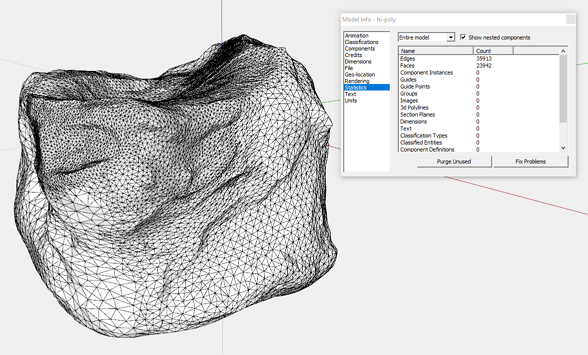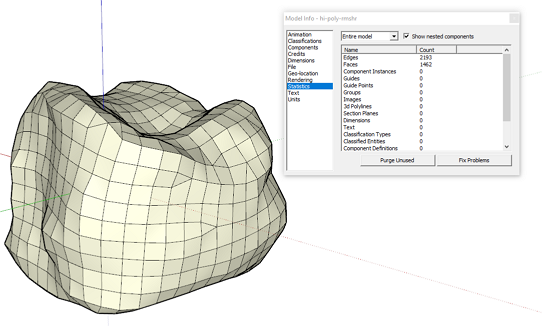Vertex tools
-
I guess I want a way to target move using a start and stop point (snapped) while having soft select, but maybe that doesn't jibe with what soft select is doing.
-
@jql said:
Why is it random if you pick the top vertice, for instance. If the topmost vertice is correctly inferenced and the bottom vertixe is at 0, I can be sure of the total height of a given "vertex sculpture".
The difficult thing is figuring out what people would expect. You say top-most vertex in this case, what if they are all on the same plane? Which vertex do you use as a base point then? (Inference snap in all directions.) And what makes top-most vertex more logical than bottom-most?
For snapping to be reliable there needs to be some predictability.@pbacot said:
I guess I want a way to target move using a start and stop point (snapped) while having soft select, but maybe that doesn't jibe with what soft select is doing.
That you can already do by using the Move tool in Vertex Tools.
-
@thomthom said:
The difficult thing is figuring out what people would expect. You say top-most vertex in this case, what if they are all on the same plane? Which vertex do you use as a base point then? (Inference snap in all directions.) And what makes top-most vertex more logical than bottom-most?
For snapping to be reliable there needs to be some predictability.I don't think you understood the original FR. When you use Fredo Box Scale to target, for instance, you scale your object by using any reference point, even points which do not belong to the object.
When I said I wanted to align topmost point, it was an example. In fact, what I think would be nice, would be for your users to:
- Hit scale and then;
- Choose a reference point in the object;
- Use inferencing system to align it to any other reference point in model.
That vertice would scale to that inference and all other vertexes would scale porportionally.
The point you'd choose would be user defined, not automatically chosen by the plugin. If this would be true for most commands, like move vertices, extend faces, etc, it would be very interesting as it would become less visual guessing and more accurate.
This lack of accuracy is the main thing that prevents me from using vertex tools so I imagine there are other people in the same situation.
If you want I can create a gif to make it clearer.
-
Yes please image(s)!

-
Are we not talking about the Gizmo any more?
-
@pilou said:
Yes please image(s)!

I have to reinstal Vertex tools. It will take some time.
@thomthom said:
Are we not talking about the Gizmo any more?
Yes I believe we could be talking about it:
- If you select the area you want to affect and then you are able to place the gizmo on the reference vertex, you could then scale, move, rotate, etc, in a way that it would then snap to an inference in the model.
I am not able to do an animated mockup of the gizmo though... I could try making a still image of the gizmo mockup if you'd like...
-
@jql said:
Yes I believe we could be talking about it:
- If you select the area you want to affect and then you are able to place the gizmo on the reference vertex, you could then scale, move, rotate, etc, in a way that it would then snap to an inference in the model.
Right, so you actually invoke an explicit pick of the reference point up front. That's an interesting idea. Basically, the inference will relate to the gizmo origin - then that combined with better custom placement of the gizmo. Do I interpret that right?
-
Yes, I believe you are interpreting it right!
It would be very cool if you'd want to further think on that subject. Having inference for scaling, moving and rotating would be key for accuracy.
Usually when people move the gizmo around in other software (take a look at Layout for instance) it acts as the reference point for the move, or a center point for rotate or scale.
This would be probably the intuitive aproach and my starting idea. Scaling or Rotating from the centerpoint using a point and an inference for accuracy might be trickier though.
Moving the gizmo to a vertice or a model reference, and then moving that point to a precise place, while keeping the gradient effect and affecting the mesh would be intuitive.
Moving the gizmo, as a centerpoint for rotation would also work nicelly, especially if it would also for a numeric angle input.
Moving the gizmo and use it as the center point for scale would also be great and also with a numeric input for multiplier.
However having the gizmo move and then also allow for a reference point to move/rotate to an inference, would probably require an off gizmo aproach.
You can see that on FredoScale box scaling/box stretching to target and also on fredo scale rotation. It works great and intuitivelly.
In your tool, in order that you can stay on the tool and keep using the gizmo without interruption, you would probably require a modifier key to be pressed while you were either scaling or rotating. It would then triger the reference+inference mechanism which would allow you to choose the reference point with a click and a Sketchup inference with a second click.
For scale, it would then move the point from it's original position to the inference and the mesh would scale proportionally from the gizmo placement.
For rotate, it would rotate the point towards the inference, as the Sketchup rotate tool does.
What Sketchup isn't able to do is everything else VErtex tools is able to.
-
I'm with you guys.
-
This is good stuff. Once I get SUbD v2 out the door VT 2 is on the radar - and the Gizmo is top on the list.
-
@thomthom said:
This is good stuff. Once I get SUbD v2 out the door VT 2 is on the radar - and the Gizmo is top on the list.
Great!
-
Great news!
I hope that the ability to select "horizontal" when selecting the "make planar" and select which vertex will be the one that determines the height of the plane.

Similarly, the ability to select a row of vertices and put them into a straight horizontal line with the z-height determined by a specific vertex.
I'm confused: the current version already has that great gizmo.

-
@bob james said:
I'm confused: the current version already has that great gizmo.

It does Bob. But the gizmo is lacking XY | ZX | ZY translations and the scaling handles need to snap incrementally.
Also the translation handles need to accept numeric input.
That said VT is still the best extension ever made
 IMHO
IMHO -
@rich o brien said:
That said VT is still the best extension ever made
 IMHO
IMHOThat is clearly wrong, the best one is Edgetools2 splitface tool along with SectionCutFace
-
Not that I care, but in the interests of accuracy, you need two tools to beat Rich's one.
-
Fo shizzle...
There's also something brewing called ReMeshR....



-
@box said:
Not that I care, but in the interests of accuracy, you need two tools to beat Rich's one.
Let's say I can't decide which one of them is the best, I'd put them both above everything else basically.

-
@rich o brien said:
Fo shizzle...
There's also something brewing called ReMeshR....
[attachment=1:jarulvus]<!-- ia1 -->Image 1.png<!-- ia1 -->[/attachment:jarulvus]
[attachment=0:jarulvus]<!-- ia0 -->Image 2.png<!-- ia0 -->[/attachment:jarulvus]

So there is sound on that silence!
-
Quietly moving forward.
WrapR goes to open beta soon.
-
The sooner it's on sale the sooner I'll get to brag again about multigroups, atlases and UDIM...

Advertisement







